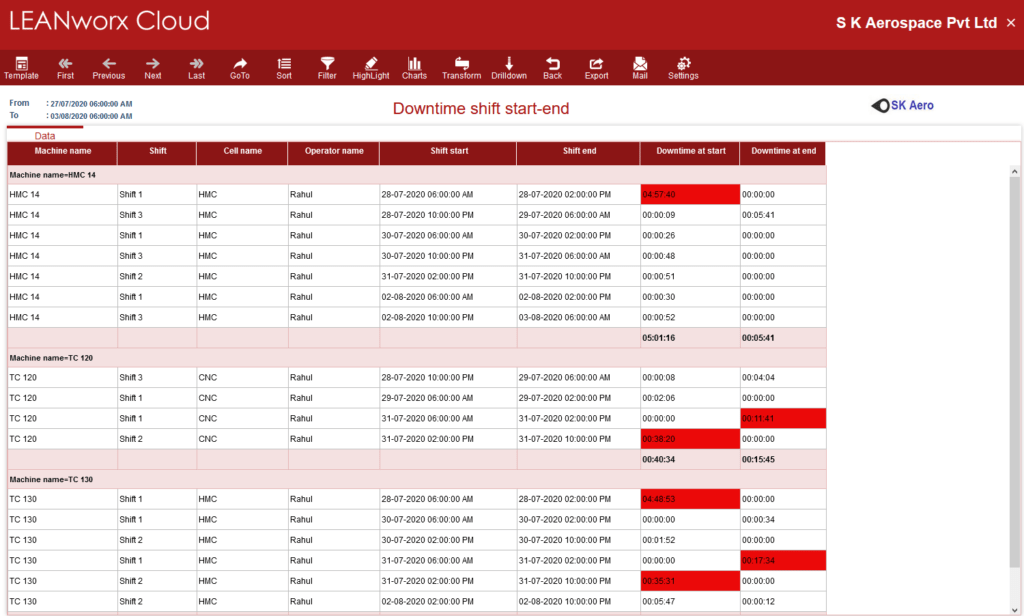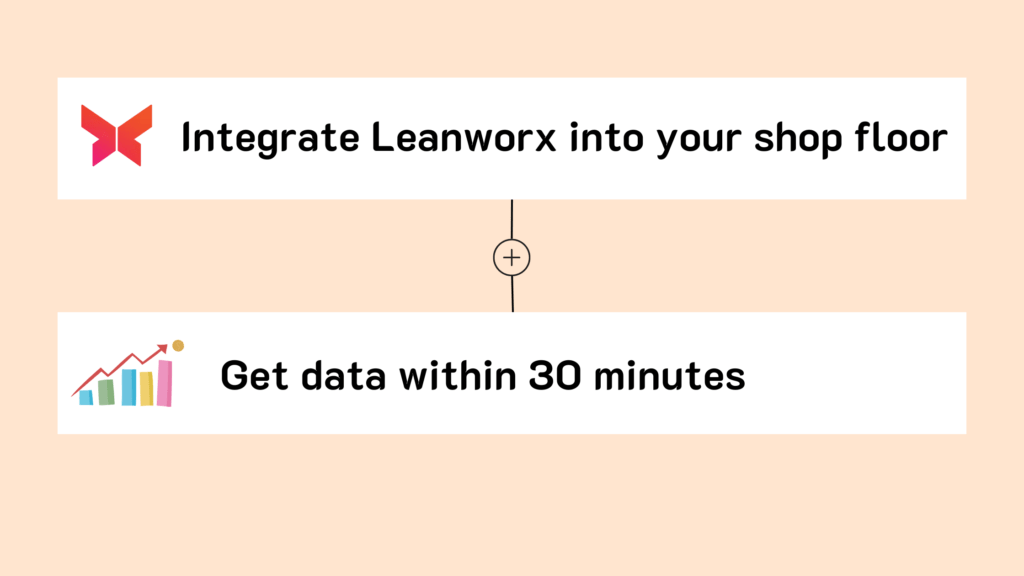
Dasarathi G V
Director in Leanworx
Dasarathi has extensive experience in CNC programming, tooling, and managing shop floors. His expertise extends to the architecture, testing, and support of CAD/CAM, DNC, and Industry 4.0 systems.
Try Leanworx for free
The Difference Between Good and Great? Precision in Tracking Machine Downtime
In today’s high-mix, high-volume manufacturing environments, consistency is the leading factor that keeps manufacturers relevant and thriving. Thus, consistent production output is more than simply a goal for modern manufacturers; it is a must for success and will soon become a must for survival.
Common issues such as process variations, rework, and unscheduled downtime strain resources and significantly reduce productivity. According to Forbes, the average manufacturer loses more than 15 hours of production time per week, totalling over 800 hours of unscheduled downtime per year. A shopfloor without a production downtime tracker fails to control the frequent unplanned downtime and loses approximately 1-10% of its annual production. The inability to track these inefficiencies not only has financial effects but also negatively impacts quality, delays delivery, and interrupts workflows, limiting operational excellence.
Start using Leanworx for free
We provide a 5-day free demo, with assistance in installation and usage.
What is a production downtime tracker?
It is a smart digital system used to monitor, record, and analyse the time when machinery or production lines are not operational. It helps manufacturers to understand when and why downtime occurs, ultimately allowing them to mitigate losses and increase production efficiency.

Why is measuring machine downtime important?
In many manufacturing shops, up to 40% of the time, machines are idle. Strangely, this is often accepted as the norm. It’s like spending a lot of money on a group of powerful workhorses only to let them sleep for almost half the day. But that doesn’t change the fact that you still have to pay for their maintenance, including power, floor space, and operator salaries, irrespective of whether they are operating or not.
A big part of the issue comes from delayed or inaccurate visibility. For instance, when a CNC or any other machine with an Andon board fails, the problem doesn’t show up on the Andon board until 15-30 minutes later; this is consistent with practically every other machine. And by the time the maintenance team arrives, 15 minutes of productive time have already gone.
Another common issue is incorrect production data. Consider a part with a tight delivery timeline that is taking longer to manufacture than expected due to difficulties with the process. However, due to incorrect machine input or data entry, the Andon board displays normal or even positive data and insights about the production processes. In such cases, everyone assumes everything is on track until it’s too late to catch up. These hidden losses increase the cost of machine idle time, turning what appears to be smooth production into a silent drain on performance, deadlines, and manufacturers’ reputations, in worst cases.
Consider another actual instance of a regular practice of any shop floor(ToolChange): A CNC machine that should run 16 hours a day under ideal conditions. If it stops unexpectedly for 2 hours due to a tool change or maintenance issue, the downtime tracker logs the exact time, duration, and unexpected reason. This data helps the PPC teams to fix recurring issues and reduce unplanned downtimes in the future.
What can you expect from a real production downtime tracker?
A digital engineering system for monitoring and evaluating downtime on shopfloors in real-time allows manufacturers to identify bottlenecks, lower variability, and apply consistent improvements on production lines by providing actionable insights about the machine’s performance, cycle times, and process compliance. It offers manufacturers a strategic viewpoint, allowing them to make informed decisions. With such digital monitoring features, the PPC team does not have to rely on Andon board and manual tracking. Instead, they have better control and transparency over everyday operations.
Importance of Automated Downtime Tracking
When a machine stops, every minute lost is money out the door and relying on operators to manually record downtime doesn’t cut it anymore. That’s where automated downtime tracking comes to the rescue.

Every shopfloor has some level of tracking, both manual and machine-based, but putting together and acting on such trackers takes a long time. Simply put, data and trackers are successful when automated, giving you enough time to react and prevent the domino effect. In addition, numbers are only helpful when they show where to look and what to fix while giving adequate time to react. Most Indian SMEs and MSMEs are unable to efficiently act on it even after having the relevant data about what is wrong with their operations. The automated downtime tracking is the answer to all these. In this case, it does more than just collect data; it organises it in a way that displays both real-time production behaviour and long-term tendencies. The following sequence reflects the usual workflow of a production downtime tracker on the shopfloor, which closely matches the operational model of Leanworx’s downtime tracker feature and how it reduces shopfloor downtime.
- To identify process drift, Cycle Time Variance is compared to theoretical standards. Small variations can reveal issues like tool wear, unsuitable feeds, or inconsistent operator inputs.
- At a much finer level, OEE Breakdown splits efficiency into three categories: availability, performance, and quality. This makes it simpler to see if slow pace cycles, rework, or downtime are lowering your total output.
- Unplanned Downtime Logging allows for faster and more accurate root-cause identification by collecting not only the event but also its context, such as machine status, operator ID, and recent tool changes.
- Yield and FPY tracking provide a clear image of how many parts have passed inspection the first time, as well as concerns with setup, tooling, and raw material consistency.
- Heat Maps clearly indicate rework clusters or zones of aberrant tool wear across machines, shifts, or part types, allowing engineers to identify high-risk regions and take focused action.
The difference Leanworx’s automated downtime tracker creates
Prior to efficiency trackers, shopfloors relied on manual, paper-based data trails, which were often delayed by 24 to 30 hours and based on recollection, assumptions, and individual honesty. This resulted in inaccurate data and limited visibility into real-time shopfloor issues, making timely corrective action nearly impossible. Our downtime tracker feature collects live data directly from machines using IoT sensors and provides it in under 30 seconds. It eliminates the need for operators, ensures 100% data accuracy, and sends actionable alerts directly to mobile devices, enabling faster, smarter, and more confident decision-making.
How can Leanworx reduce your downtime?
In manufacturing, what you don’t know is what costs you the most. Leanworx changes that by making every second, every machine, and every movement visible, measurable, and actionable. More than simply a machine-monitoring software; it is a plug-and-play digital system designed specifically for modern manufacturing. It fits well in, whether it’s a two-machine job shop or a 200-machine facility, with no infrastructure issues.
With Leanworx You Can Track:
- Machine downtime – Know exactly when and why machines stop
- Setup time & idle time – Pinpoint delays and reduce changeovers
- Late starts and early stops – Catch invisible losses daily
- Worker efficiency monitoring – Understand shift-wise productivity
- Part quality, rework & scrap – Reduce quality losses with real-time data
- Overall Equipment Effectiveness (OEE) – Get the full A-P-Q picture
- Energy Efficiency (EE) – Monitor power usage alongside production
- Production quantity in real-time – Know what’s happening now, not just at the end of the day
Increase your production efficiency now using Leanworx Try for free
Production Efficiency Starts with Knowing Where You Lose It
It’s a known fact that shopfloor efficiency is not entirely about maximising manufacturing speed, it is also about minimising unpredictable downtimes. A production downtime tracker provides manufacturers with the visibility they need to identify silent losses on the shopfloor. By translating machine behaviour, human inputs, and process variability into accurate, real-time data, it allows manufacturers to make smarter decisions rooted in consistency, adherence, and repeatability.
This clarity serves as a base for leaner operations, better utilisation, and confident scaling, turning downtime into an opportunity and data into long-term progress. With a free trial version of Leanworx, any manufacturer can use and test it regardless of their facility size. And, at the pace at which the Indian manufacturing space is growing, manufacturers must prioritise and integrate such technology faster.
Increase your profits automatically. Use Leanworx to get accurate and instant data 24/7.


